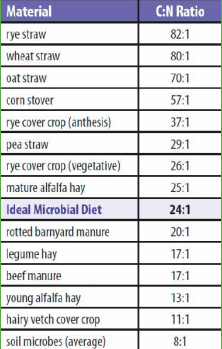Written byAngela Lovell, originally published in No-Till Farmer USA in November 2018
Choosing a cover crop cocktail is only a start, says Adam Daugherty, as managing carbon-to-nitrogen ratios and adapting planting strategies play a big role in success. There are many variables for growers to consider when they’re implementing cover-crop mixes into their no-till rotation — including mix design, carbonto-nitrogen (C:N) ratios, cash crop goals, termination strategies and biomass management. “The goals will be different for everyone and will change from field to field, with changing conditions and with time,” says NRCS district conservationist Adam Daugherty.

Here are strategies for thinking through some of these important decisions that were shared by Daugherty at the National No-Tillage Conference last January. Staying in Balance It’s vitally important for no-tillers to understand the C:N ratio of crop residue and how they play a role in the soil. C:N ratios are especially important when ascertaining how long it will take for soil microbes to break down residue. “The soil is a jungle ecosystem,” says Daugherty. “It has big and little critters. They all have to eat and they all play a role in cycling residue.” The ideal C:N ratio to feed microbiology in the soil, so it can efficiently consume biomass and cycle nutrients, is 24:1. Higher C:N ratios will slow down the decomposition of biomass and lower C:N ratios will speed it up, Daugherty says.
Most annual cropping systems have a high C:N ratio: wheat straw is 80:1 and corn stover is 57:1, which means residue decomposes slowly and leaves more protective biomass on the soil surface. Plants with a lower C:N ratio (legume hay is 17:1) decompose residue faster and result in less cover being left on the soil surface. Daugherty generally advises no-tillers to stay on the high end of the C:N ratio because one of the first things that destroys soil function is leaving it naked. “I want to keep the soil covered the best I can so I shift a little to the high side on the C:N ratio, especially in fields that have had cover crops for a couple of years and I’m getting a good idea of what they’ve got going on,” he says.

Keep it Simple
Don’t over-complicate cover-crop mixes, advises Daugherty, but aim for one that has at least some diversity with grasses, legumes and brassicas. What generally works for Daugherty’s growers is 20 pounds an acre of legumes, 40 pounds an acre of grasses and 2 pounds of brassicas. To achieve this ratio, a fairly common mix would be 10 pounds per acre each Austrian winter peas and oats, 5 pounds of crimson clover, 5 pounds of hairy vetch, 15 pounds each of cereal rye and triticale, 1½ pounds of Daikon radish and ½-pound of another broadleaf. “That’s a common mix for us and we can manage that mix to achieve a lower or higher ratio,” says Daugherty. “That’s another thing that diversity will let you do — get more flexibility in managing your C:N ratios.” He recommends growers try out online cover-crop calculators to see how different species, maturities and percentages can alter the C:N ratio.
Management Comes First
Daugherty says it’s better to manage a less-ambitious mix properly than choose a “silver-bullet mix” and manage it poorly. “I design in the fall and manage in the spring for my desired results. This is going to hold true no matter where you’re at,” he says. “You can do the same thing with summer mixes. It all boils down to what my goals are for the field and the logistics that I’m going to manage to reach those goals in the spring.”
Happy Medium
The ideal carbon-to-nitrogen (C:N) ratio to feed soil microbiology — so it can efficiently consume biomass and cycle nutrients — is 24:1, says Adam Daugherty. Higher C:N ratios will slow down the decomposition of biomass and lower C:N ratios will speed it up, so it’s best for no-tillers to look for balance in their cover-crop mixes.

No-tillers should always be ready for something unexpected to happen and have a Plan B to deal with it. Daugherty showed growers a slide of two fields planted side by side with the same cover crop mix, on the same day and managed the same way, and while one field was an explosion of diversity the other was almost entirely heavy vetch. “I don’t know what went on, but I think that the soil gets the ability to dominate what species it needs growing,” he says. “We now have to manage this field differently and set up to plant differently. Even though we planned everything in the fall, sometimes crazy stuff happens, but it’s not the end of the world. We can manage anything.”

Art, Not Science
Growing cover crops is an art, not an exact science, says Daugherty. “You cannot write one recipe and just stick to it,” he says. “You’ve got to be very dynamic in your thought process. You have got to be able to switch on the go and do something different on Wednesday than you did Monday. It’s that variable.” Specifically, it’s important to do regular soil evaluations and analyse not just the nitrogen (N), phosphorus and potassium values but things such as microbial biomass, diversity index, organic matter, fungi and CO₂ content. That will help to determine the cover-crop mix and management that fits best.
“We can use this data up front to start making predictions, so we don’t plant something with too low a C:N ratio that we know is going to disintegrate,” Daugherty says.
Look and Listen
The final grade card is learning to read your field, Daugherty says. He cautions that there’s no soil test available that is more effective than growers who develop an ability to read the symptoms of what’s happening in their fields. Once a grower gets soil biology activated and working properly, they must keep feeding it to ensure there’s enough of what the system requires — especially carbon — to meet both soil and crop needs. “Carbon is our limiting nutrient, but liquid carbon is a different feed from other forms, like organic matter,” says Daugherty.
“Primarily we’ll be growing a monoculture cash crop and for at least half the year we’re going to be very nondiverse in a system that wants to be diverse. “In general, as soil biology functions increase, more carbon needs to be managed in the mix.” Growers must monitor stand establishment of their cash crops, assess the amount of residue left on the ground throughout the crop’s growth cycle and, in the end, determine if they have achieved their goals for the crop and the soil. “I don’t really worry about this when I’m starting with a degraded system,” Daugherty says. “I want to start priming it with a lower C:N ratio. But three or four years on, as the system begins to work, you’ve got to start watching this.”
Seed Depth Rules
What never changes with a cover crop is the planting depth for the following cash crop. “If you don’t want a yield drag, whether it’s clean dirt, no-till dirt or biomass dirt, you have to plant at the right depth,” Daugherty says. “Covers are forgiving of a lot of things but that doesn’t mean you can go out there and broadcast corn.” “In general, as the soil biology functions increase, more carbon needs to be managed in the mix…”— Adam Daugherty What typically works for planting in Daugherty’s area of south-eastern Tennessee is working in good-to-dry conditions using a smooth, solid closing wheel which can be changed to a spiked closing wheel in wetter conditions.
Wrapping isn’t usually a problem when planting into green crops that are crimped or rolled as long as growers plant in the same direction as the crops are laying, he says. Growers in Coffee County generally have a fair amount of moisture during the spring and fall, which in their heavy clay loam soils means they have to be careful to avoid compaction of the seed trench. Cover crops are a definite plus in these conditions, especially when growers plant into green crops pre-harvest, but Daugherty notes the firmness of the ground underneath the cover crops or post-harvest residue is still an important consideration. He advises no-tillers evaluate the seed trench by reading the sidewalls. “When you start seeing air pockets there, let it dry up a day,” he says. “Just because you’re planting into covers doesn’t mean you can muddle corn in.”
Low and High
Planting cash crops into low or medium biomass situations requires different techniques, Daugherty explains. With low-biomass cover crops — which he defines as 6,000 pounds of biomass per acre or less — the cash crop is easier to plant, even when it’s into a cover crop. There’s generally no need to roll or crimp it to the ground first. “With low-biomass planting, I highly recommend no-tillers leave it green because your planting window is going to be a lot wider,” he says. “Once you spray it, you’re at the mercy of the sunshine and the rainfall.
There is nothing else out there to manage with. There won’t be any wrapping when you’re planting into this stuff.” What growers need to watch in a lowbiomass cover crop is that the following cash crop — especially a heavy feeder like corn — can begin to run out of carbon as the residue begins to disappear by June or July. “You can still grow good corn. Infiltration and a lot of things are better, but it’s not bio mimicry,” he says. “You’re not rejuvenating the resources to the degree that you can, so you won’t have the results you could potentially get.” In a medium situation with 6,000- 10,000 pounds of biomass per acre, Daugherty says growers can make tremendous strides and achieve extreme resource
